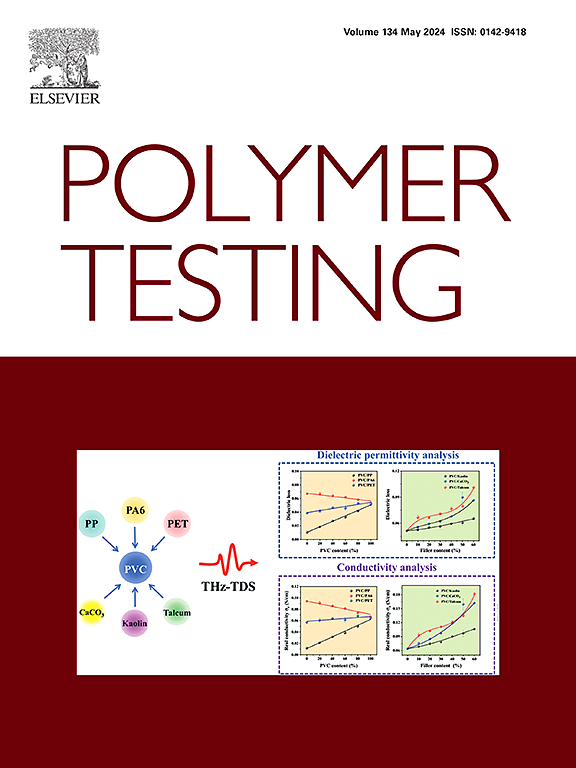Enhancing energy harvesting capabilities using lead-free, flexible piezoelectric poly (vinylidene fluoride) tapes
IF 5
2区 材料科学
Q1 MATERIALS SCIENCE, CHARACTERIZATION & TESTING
引用次数: 0
Abstract
Poly(vinylidene fluoride) (PVDF) has been widely investigated as an energy harvesting material not only for its piezoelectric properties but also for being flexible, lead-free piezoelectric properties, and processing versatility. To enhance its piezoelectric performance, in this study, an additive was blended with PVDF to facilitate the crystalline transformation from α-phase to β-phase. This study explores the influence of two manufacturing processes, extrusion (EX) and compression moulding (CM), and the influence of different stretching and polarisation conditions on the piezoelectric performance of PVDF tapes for their integration into a cantilever beam for energy harvesting applications. The heat stretching process for EX and CM tapes was conducted at distinct temperatures (80° and 120 °C) and stretching speeds (300 and 10 mm/min), leading to different stretch ratios (3.0 and 4.50) that effectively raised the β-phase. Structural changes in the crystalline phases were identified using X-ray diffraction and Fourier transform infrared spectroscopy. Following this, the dipoles were oriented in the direction of an applied electric field (400–500 kV/cm). The piezoelectric performance was characterized by d33 values, and peak-to-peak voltage, under sinusoidal tensile stress, was obtained using a universal tensile testing machine. A d33 value of 25–30 pC/N and a peak-to-peak voltage of 27–35 V were obtained. Additionally, the piezoelectric behaviour was observed by arranging the tapes in a cantilever made of fibreglass composite and subjecting it to vibrational excitation at the resonance frequency. Maximum values of output voltage of 12 V for each tape were obtained under cantilever fixture.
利用无铅柔性压电聚偏氟乙烯磁带增强能量收集能力
聚偏氟乙烯(PVDF)作为一种能量收集材料,不仅由于其压电特性,而且由于其柔性、无铅压电特性和加工通用性而受到广泛的研究。为了提高其压电性能,本研究在PVDF中掺入添加剂,促进α-相向β-相转变。本研究探讨了挤出(EX)和压缩成型(CM)两种制造工艺的影响,以及不同的拉伸和极化条件对PVDF带的压电性能的影响,以便将其集成到用于能量收集应用的悬臂梁中。在不同的温度(80°和120°C)和拉伸速度(300和10 mm/min)下对EX和CM带进行热拉伸过程,得到不同的拉伸比(3.0和4.50),有效地提高了β相。利用x射线衍射和傅里叶变换红外光谱分析了晶体相的结构变化。在此之后,偶极子在外加电场(400-500 kV/cm)的方向上定向。用d33值表征了压电性能,并利用万能拉伸试验机获得了正弦拉应力下的峰值电压。d33值为25-30 pC/N,峰间电压为27-35 V。此外,通过将胶带放置在由玻璃纤维复合材料制成的悬臂中并使其在共振频率下受到振动激励,可以观察到压电行为。在悬臂式夹具下,每条胶带的最大输出电压为12v。
本文章由计算机程序翻译,如有差异,请以英文原文为准。
求助全文
约1分钟内获得全文
求助全文
来源期刊

Polymer Testing
工程技术-材料科学:表征与测试
CiteScore
10.70
自引率
5.90%
发文量
328
审稿时长
44 days
期刊介绍:
Polymer Testing focuses on the testing, analysis and characterization of polymer materials, including both synthetic and natural or biobased polymers. Novel testing methods and the testing of novel polymeric materials in bulk, solution and dispersion is covered. In addition, we welcome the submission of the testing of polymeric materials for a wide range of applications and industrial products as well as nanoscale characterization.
The scope includes but is not limited to the following main topics:
Novel testing methods and Chemical analysis
• mechanical, thermal, electrical, chemical, imaging, spectroscopy, scattering and rheology
Physical properties and behaviour of novel polymer systems
• nanoscale properties, morphology, transport properties
Degradation and recycling of polymeric materials when combined with novel testing or characterization methods
• degradation, biodegradation, ageing and fire retardancy
Modelling and Simulation work will be only considered when it is linked to new or previously published experimental results.
 求助内容:
求助内容: 应助结果提醒方式:
应助结果提醒方式:


